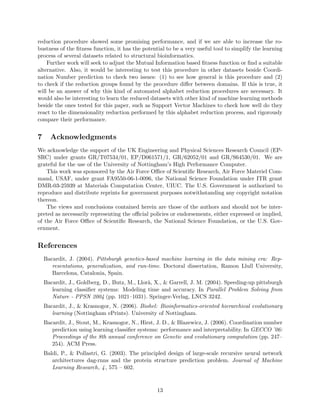Automated alphabet reduction with evolutionary algorithms for protein structure prediction
This paper focuses on automated procedures to reduce the dimensionality of protein structure prediction datasets by simplifying the way in which the primary sequence of a protein is represented. The potential benefits of this procedure are faster and easier learning process as well as the generation of more compact and human-readable classifiers. The dimensionality reduction procedure we propose consists on the reduction of the 20-letter amino acid (AA) alphabet, which is normally used to specify a protein sequence, into a lower cardinality alphabet. This reduction comes about by a clustering of AA types accordingly to their physical and chemical similarity. Our automated reduction procedure is guided by a fitness function based on the Mutual Information between the AA-based input attributes of the dataset and the protein structure feature that being predicted. <br /> To search for the optimal reduction, the Extended Compact Genetic Algorithm (ECGA) was used, and afterwards the results of this process were fed into (and validated by) BioHEL, a genetics-based machine learning technique. BioHEL used the reduced alphabet to induce rules for protein structure prediction features. BioHEL results are compared to two standard machine learning systems. Our results show that it is possible to reduce the size of the alphabet used for prediction from twenty to just three letters resulting in more compact, i.e. interpretable, rules. Also, a protein-wise accuracy performance measure suggests that the loss of accuracy accrued by this substantial alphabet reduction is not statistically significant when compared to the full alphabet.
















Recommended




























































More Related Content
What's hot (10)




















Viewers also liked (6)












Similar to Automated alphabet reduction with evolutionary algorithms for protein structure prediction (20)








































More from kknsastry (20)






































Recently uploaded (20)































